|
CONTENTS
"Babe" on the Mound
MVP 1-2-3
Billards vs Baseball
HOF SS Fielding Percentages
We Apologize, Willie
World Series Ends on Bases
They Didn't Have to Carry Her around the Bases
Cubs' Bargain
Only First-Start No-Hitter
Odd Schedule Years
Braves Get Bargain at SS
SS Trevor Hoffman
Wills '62 vs Ruth '20
Two Fordham Second Sackers
Record-Setting Debuts
Baseball
Did You Know – I
Baseball
Did You Know – II
Baseball
Did You Know – III
Baseball
Did You Know – V
Baseball
Did You Know – VI
Baseball
Did You Know – VII
Baseball Page
Top
of Page |
Baseball
Did You Know? – IV
"Babe" on the Mound – But Not the One You Think
Babe Didrikson is considered by many the greatest female athlete of all time.
- The Associated Press voted her the Greatest Female Athlete of the first half of the 20th century.
- The AP also chose her Female Athlete of the Year six times – once for her track dominance and five times for her golfing prowess.
- While she qualified for five events for the 1932 Olympics in Los Angeles, women were allowed to compete in only three. She won the first women's Olympic javelin (143 feet, 4 inches) and set a world record in winning the first Olympic 80-meter hurdles (11.7 seconds). In the high jump, she tied for first but was disqualified in a disupted ruling.
- In golf, she could drive the ball 250 yards and dominated women's events for 20 years, winning 31 tournaments until her early death from cancer at age 45.
She said that she was called "Babe" in her teens because boys were envious of her Ruthian drives in baseball. So it was inevitable that she would have some connection with baseball as an adult.
In 1934, she pitched several games in spring training against major league teams. Hurling for the Philadelphia Athletics (some sources say the Phillies), she shutout the Brooklyn Dodgers for an inning. That same year, she joined the touring House of David baseball team. She supposedly struck out Joe DiMaggio in one of the exhibition games.
|
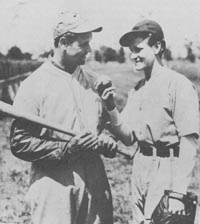
Babe Didrikson with Jimmy Foxx |
|
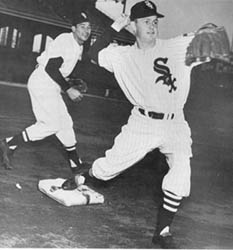
Luis Aparicio & Nellie Fox |
On three occasions, members of the same team have finished 1-2-3 in the MVP voting for their league.
-
1941 Brooklyn Dodgers: 1B Dolf Camilli, CF Pete Reiser, P Whitlow Wyatt
-
1959 Chicago White Sox: 2B Nellie Fox, SS Luis Aparicio, P Early Wynn – all three in the Hall of Fame
-
1966 Baltimore Orioles: RF Frank Robinson, 3B Brooks Robinson, 1B Boog Powell – the first two in the Hall of Fame
All three teams, as you would expect, won the pennant. However, only the Orioles captured the World Series, defeating the Los Angeles Dodgers four straight.
|
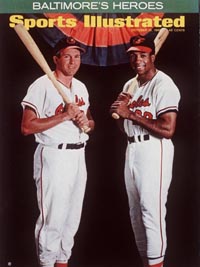
Brooks and Frank Robinson |
|
The Chicago Cubs once won three pennants in four years and might have won the fourth if not for the loss of their catcher.
You know we're talking about long ago, and you're right. The Cubs won back-to-back World Series in 1907 and 1908. Then, after finishing second to the Pittsburgh Pirates in 1909, won the pennant again in 1910, although they lost to the Philadelphia A's in the World Series. What happened before the 1909 season to spoil their quad-fecta (if there is such a word)?
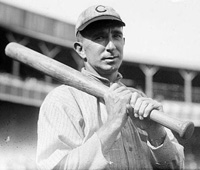
Johnny Kling |
During the winter between the 1908 and 1909 seasons, the Cubs' 35-year old C Johnny "Noisy" Kling (nicknamed for his constant chatter on the diamond), generally considered the best in the league, won the world pocket billiard championship. He then did not play the entire 1909 season. The reason for his absence is still disputed.
- Opinion #1: Since billiards provided an opportunity to make more money than he earned from baseball, he retired from the diamond to concentrate on pool and defend his championship.
- Opinion #2: He used billiards as a bargaining chip with the Cubs and thus was, in effect, baseball's first holdout. He organized and played for a semi-pro team in his hometown of Kansas City during 1909. And, when he returned for the 1910 season, he was fined $700 by the National Baseball Commission, which ran the game in those days, and forced to play the 1910 season at his 1908 salary of $4,500.
- Opinion #3: In March, 1909, Kling sent a telegram to manager Frank Chance: "Don't expect me this season, as I find it impossible to trust my business here [Kansas City] in other hands. No question of salary, but my manager here is not capable of handling my affairs in the proper way. Things are breaking too well for me to leave, as my prospects here are the brightest. Best wishes to you and the boys."
|
At any rate, Johnny helped the Cubs win the 1910 pennant despite playing only 91 games. Traded to Boston during the 1911 season, Kling played through 1913, after which he retired for good and operated successful businesses in Kansas City, including - what else? - a billiards parlor.
Additional note on Kling: Some players called him "the Jew" because it was thought he was part Jewish. However, his wife insisted after his death in 1947 that he was not Jewish and was in fact baptized as a Christian. However, others say her motive in saying that was to make sure he was not denied a place in the Hall of Fame because of anti-Semitism. Researchers have been unable to put together a convincing argument one way or the other concerning his ethnicity. In either case, he has never been elected to Cooperstown.
Reference: Baseball Digest, August 2008
|
HOF SS Fielding Percentages
This isn't a baseball quiz, but before reading this feature you might want to answer this question.
What Hall of Fame SS has the highest fielding average for his career?
Now you can look at these statistics.
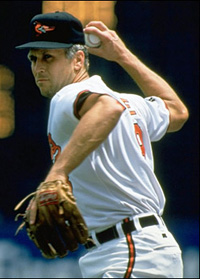
Cal Ripken |
Top Fielding Percentages for Hall of Fame Shortstops
Shortstop |
Pct. |
Cal Ripken, Jr. |
.979 |
Ozzie Smith |
.978 |
Lou Boudreau |
.973 |
Luis Aparicio |
.972 |
Ernie Banks |
.969 |
|

Ozzie Smith |
Admittedly, fielding percentage alone is an inexact measure of a fielder's defensive ability. So take the figures for what they are worth. A SS is never charged with an error on a ball he can't reach. Yet we know some cover much more ground than others.
Incidentally, Omar Vizquel, still playing with the Giants, has a lifetime fielding average of .984, which would put him at the top of the list when he is inducted into the Hall as he surely will and should be.
|
19-year old Willie Mays played his first minor league game in June, 1950, in Hagerstown MD. You would think that three years after Jackie Robinson's MLB debut and in a state outside the Deep South, Willie would not face racial taunts from the fans. But he did while playing for Trenton, the Giants' Class B affiliate. (Seems odd in retrospect – doesn't it? – that Willie Mays would start in class B.) He also had to stay at an all-black hotel apart from his teammates. "I realized that I was a pioneer, for not only was I the first black player on the team – I was the first in the entire league." (Say Hey, The Autobiography of Willie Mays)
On August 9, 2004, city officials offered Mays an appearance fee to return to Hagerstown and give absolution to the city. The Hagerstown Suns, ironically a Giants farm club at the time, hosted a number of events that day.
Return to Mays' playing career and the Giants' move to San Francisco in 1958. Surely there would be no problem in such a sophisticated city. Think again. Mays and his wife couldn't buy a home in San Francisco until the mayor intervened. Then a week after they moved in, someone threw a brick through the window. One commentator has claimed that Willie was resented because he was "the hated embodiment of New York" and he "had the temerity to play CF in Seals Stadium [the Giants' original home in SF], where the native-born DiMaggio had played in his minor league days."
|
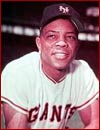 |
Reference: "Where Are They Now? Willie Mays," Sports Illustrated, July 14-21, 2008
|
World Series Ends on Bases
You may know that the 1926 World Series ended with Babe Ruth caught stealing at second in the seventh game in Yankee Stadium. That was the famous contest in which Grover Cleveland Alexander relieved in the seventh inning to strike out Tony Lazzeri with the bases loaded.
The 1921 World Series also ended with the final Yankee out recorded on the basepaths. In their first Series ever, the Yankees took the New York Giants to seven games, all played at the Polo Grounds, the home the clubs shared while Yankee Stadium was built. In the ninth inning of the eighth game (the Series was best-of-nine in those years), with the Giants ahead 6-4, Aaron Ward of the Yankees occupied first with one out. Frank "Home Run" Baker slashed a grounder toward RF which 2B Johnny Rawlings speared spectacularly and threw to first to nip Baker. Ward, assuming the ball had gone through, continued around second but was thrown out at third by a bullet throw from 1B George Kelly to 3B Frank Frisch.
|
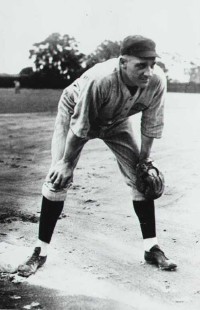
George "High Pockets" Kelly |
|
They Didn't Have to Carry Her around the Bases
An incident in a college softball game on April 26, 2008, attracted nationwide attention. A Western Oregon batter hit a grand slam but suffered a knee injury rounding first that left her incapacitated. Thinking that any assistance by her own team would cause the runner to lose her HR, several fielders of the Central Washington team carried the batter around the bases, stopping to let her touch each bag with her good leg. This act of sportsmanship won universal praise, especially since the HR helped knock Central Washington out of the playoffs. Watch the video of the play.
The coaches and umpires at the game were unaware that the assistance by the opposing team was not necessary. Softball rules, like those of baseball, allow a pinch-runner in that situation. Baseball rule 5.10 (c) states:
If an accident to a runner is such as to prevent him from proceeding to a base to which he is entitled, as on a home run hit out of the playing field, or an award of one or more bases, a substitute runner shall be permitted to complete the play.
This rule was applied on September 14, 2005, in a game between the Boston Red Sox and Toronto Blue Jays at Toronto. With Gabe Kapler on first, Tony Graffanino hit a line drive homer over the LF wall. Kapler, sprinting toward second before the ball left the park, tore his Achilles tendon and collapsed going around second. Graffanino stopped before passing Kapler. The umps called time as Red Sox manager Terry Francona came out to check on his injured player. Francona, knowing the rule, inserted Alejandro Machado as a pinch-runner to complete Kaplan's trip around the bases. Graffanino completed his two run HR. Thus Machado scored the first run of his ML career, undoubtedly the first rookie to do so in such a bizarre manner.
Reference: "Baseball Rules Corner," Rich Marazzi, Baseball Digest, September 2008
|
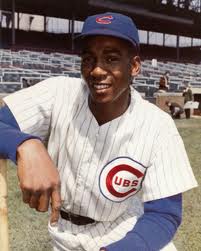
Ernie Banks |
Hall of Famer Ernie Banks didn't play high school baseball because his Dallas alma mater didn't field a team. So he attracted the attention of major league scouts by playing Negro league ball. His salary was based on a percentage of the gate. "The most I ever got was $20 for a game in Hastings NE," he said.
The Chicago Cubs bought Banks for about $25,000 when he was 22 years old. His first day in a Cub uniform, he hit the first batting practice pitch into the Wrigley Field bleachers.
Early in his career, Ernie played 717 consecutive games. Then, taking a different approach from a later SS, Cal Ripken, he removed himself from the lineup to eliminate pressures that might jeopardize his career. Still, he played in 150+ games twelve seasons during his career.
In 1982, he became the first Cub to have his uniform number (14) retired. As is well known, he never got the chance to play in a post-season game.
|
|
Only First-Start No-Hitter
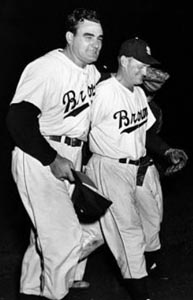
Bobo Holloman (left) leaving the field after his no-hitter
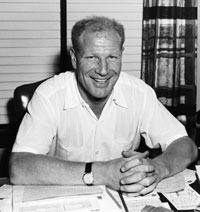
Bill Veeck
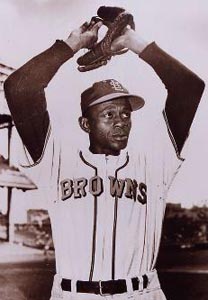
Leroy "Satchell" Paige
|
Alva Lee "Bobo" Holloman is the only man to pitch a no-hitter in his first start in the major leagues. He beat the Philadelphia A's 6-0 on May 6, 1953, for the Browns in St. Louis. Instead of launching an outstanding career for the rookie, the game turned out to be the only complete game he pitched in the majors. Further, he was sent back to the minors in late July of 1953 and never appeared in another MLB game.
Considered wild and inconsistent in the minors from 1946-1951, Holloman had an excellent year at AAA Syracuse in 1952: 16-7, ERA 2.51. Browns owner Bill Veeck then purchased him for the for $10,000 with the proviso that he would pay Syracuse another $25,000 if Bobo survived the final cut-down date.
After three relief appearances, two effective and one ineffective, Holloman was hit hard by the Washington Senators on May 1, giving up four hits and two runs in 1 1/3 inning. This made Veeck eager to save the $25,000 by cutting him. However, the rookie's argument that he had been a starter at Syracuse convinced manager Marty Marion to grant him a make-or-break start on May 6.
A mere 2,473 turned out at Sportsman Park on a wet, unpleasant evening. In fact, Veeck announced after the fifth inning that rain checks would be honored at any subsequent Browns' game as a reward for the fans who ventured out on a foul night.
Holloman's gem was rather straightforward, with only two difficult fielding plays, LF Jim Dyck's catch off Gus Zernial in the second and a line shot to SS Billy Hunter off the bat of Allie Clark in the fifth. Bobo walked five and struck out three as his sinker worked well. At the plate, he hit two singles and drove in three runs, the only hits or RBIs he recorded in the majors. The no-no occurred on the 36th anniversary of the last Browns no-hitter by Bob Groom in 1917. It turned out to be the only no-hitter in the majors during the 1953 season.
As a result of Holloman's performance, Veeck gave him either $100, a new suit, or a TV set, depending on which account you believe. Furthermore, Bill had little choice but to keep Bobo on the squad and send Syracuse the 25 grand. Holloman joined Don Larsen and Mike Blyzka to form a trio considered by the press as promising Brown rookie hurlers.
However, Bobo didn't build on his success. In his next start on May 12, he developed a blister warming up and was removed in the second inning. On May 24, he lasted only 2 1/3 innings against the Indians. He did garner his second victory on May 27 against Cleveland, 5-1, when ageless Satchell Paige took over in the sixth.
After two ineffective starts and three short relief appearances, he lasted only four innings in a 5-3 loss to New York on June 17. On June 21, Holloman earned his last major league victory, barely missing his second shutout and second complete game. He held the Red Sox to two hits in Boston before Paige got the last out in a 2-0 victory.
Thereafter, Holloman's performance deteriorated rapidly. He was ineffective in two starts and then in relief. Finally, on July 19, he had a disastrous 1 1/3 inning relief stint against the Senators, giving up six runs in a 13-4 loss. Veeck then sold him to Toronto of the International League on July 23 for only $7,500 (according to Veeck). The transaction took place only because all ML clubs waived him.
On July 26, Holloman pitched creditably before a big crowd of 12,000 in Toronto, yielding six hits in six innings before departing with a 5-1 lead. Unfortunately, he continued to pitch inconsistently as he had in St. Louis.
Bobo reported to spring training in 1954 with a sore arm. As a result, he was sent to class A and then class B teams but did not impress any of them. After playing for five teams in five different leagues by mid-August, he went home to Athens GA, never to pitch another professional game.
Reference: "Alva Lee "'Bobo' Holloman," George W. Hilton, SABR Research Journal, 1973
|
|
Most serious baseball fans know that MLB played 154-game seasons for most of the 20th century, then 162 games per year after expansion in 1961. However, there were several occasions when longer slates were proposed.
- When the American League met in August 1946, Larry MacPhail, president of the Yankees, proposed a 168-game schedule to capitalize on baseball's popularity following World War II. Each of the eight teams would play every other team 24 times. However, the public reacted negatively when the plan was announced. As a result, Boston's Tom Yawkey convinced his fellow owners at the September meeting to continue the 154-game schedule, which then remained in effect until 1961.
- 1961 marked the only season when the two major leagues did not play schedules of equal length. The AL moved to a 162-game slate because it had added two teams – the Los Angeles Angels and Washington, which had lost the Senators to Minnesota the year before. The NL caught up the following year when it added the Houston Colt-45s and the New York Mets.
- When the NL agreed to add two more teams for the 1969 season (Montreal and San Diego), the owners tenatively agreed to a 165-game schedule with each team playing every other team 15 times. However, the league ultimately went along with the junior circuit plan, which created two divisions of six teams with teams playing more games against the opponents in its division. (The AL expanded to Kansas City and Seattle for '69.)
|

Hank Aaron |
Hank Aaron was a skinny SS with Indianapolis of the Negro American League in 1952 when he was discovered by Braves scout Dewey Griggs. Boston signed Hank for $10,000.
After two seasons as an infielder with Eau Claire of the Northern League and Jacksonville of the Sally League, Aaron won an OF berth with the Braves when Bobby Thomson fractured an ankle during a spring exhibition game. Three years later, Aaron was the NL MVP on the Milwaukee Braves' World Series champions.
On May 17, 1970, Hank beat out an IF hit in Cincinnati to become the first player ever to register both 3,000 hits and 500 HRs. Four years later, Aaron broke Babe Ruth's lifetime record of 714 HRs.
|
|
 |
Trevor Hoffman of the San Diego Padres is baseball's all-time saves leader. But he didn't start out as a pitcher.
In his last season at the University of Arizona, SS Hoffman hit .371 and was chosen in the 11th round by the Cincinnati Reds. Two years later, struggling at Charleston (WV), he was benched. Even though Trevor had not pitched in high school or college, a scout put "infielder/pitcher" on his report because Hoffman had a good arm. So he started throwing in the bullpen every third day. After a few sessions, one of the coaches told him, "You're not going to be playing infield anymore."
40-year old Hoffman also credits the uncountable hours he has spent running from foul pole to foul pole in ballparks all over the majors. "Running is such a chore, but if I didn't do it, I wouldn't be prepared to do my job."
Reference: The Sporting News, 9/1/2008
|
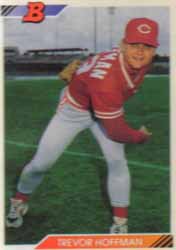 |
|
Maury Wills' 1962 season has been compared to Babe Ruth's 1920 campaign in terms of domination in a statistical category. Why is a singles-hitting SS mentioned in the same sentence with the greatest slugger of all time? Here's why.
- 1920: Babe Ruth hit 54 HRs in his first year with the Yankees, breaking his own record of 29 he set with the Red Sox the previous season. His 54 clouts surpassed the total of every other team in the American League and of seven of the eight teams in the National League. (The Philadelphia Phillies hit 64 playing in tiny Baker Bowl.)
- 1962: Maury Wills stole 104 bases to break Ty Cobb's single-season record of 96 set in 1915. Wills' total surpassed the SB total of every team in the major leagues. The closest to him were the Washington Senators, who pilfered 99 sacks. Maury's Dodger teammates stole 94, while the Cardinals racked up 86.
Reference: SABR Baseball Records Committee, October 2008
|
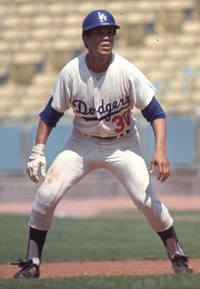
Maury Wills |
|
Two Fordham Second Sackers
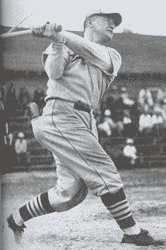
Frank Frisch |
Ken Auerbach is a 65-year-old financial consultant who lives in Bronxville NY. He sends out sports trivia questions by e-mail to over 100 people ranging in age from their 20s to 70s. Since he was featured in a New York Times article in October, 2008, he has undoubtedly had many more requests from people wanting to be added to his list.
One of Ken's favorite questions is this: "Can you name two Fordham University second basemen who became Cardinals?"
- One obvious answer is the "Fordham Flash," Frankie Frisch, who starred in football, basketball, and track as well as baseball in college. He played eight seasons for the New York Giants before being traded to the St. Louis Cardinals in 1926. He is most famous for managing the Gashouse Gang to the 1934 World Championship. He was inducted into the Hall of Fame in 1947.
- The other half of the answer is Frankie Spellman, who actually was the backup second baseman to Jack Coffey a decade before Frisch played at Fordham. Spellman is better known as Francis Cardinal Spellman, longtime archbishop of New York.
|
|
Here are some records for players' major league debuts.

Mark Quinn
|
- Home Runs: Four players hit two in their first game, the most recent being Mark Quinn of the Kansas City Royals in 1999. The others were Bert Campaneris, Kansas City Athletics, in 1964, Bob Nieman, St. Louis Browns, 1951, and Charley Reilly, Columbus Solons, 1889.
- Hits: Fred Clark of the Louisville Colonels in 1894 and Cecil Travis of the Washington Senators in 1933 had five hits in their first ML game.
- RBIs: Five is the record, attained by four players. The most recent was Ben Grieve of the Oakland A's in 1997. Extra note on Ben Grieve: He and his father Tom were the first father and son to be selected in the first round of the MLB draft. Tom was taken sixth by the Senators in 1966, Ben second by Oakland in 1994.
- Strikeouts: Karl Spooner had 15 strikeouts in his MLB debut in 1954 for the Brooklyn Dodgers. Then J. R. Richard of the Houston Astros duplicated the feat in 1971. Spooner also set a record by striking out the first six batters he faced. He made only two starts in 1954, both complete-game shutouts. However, arm trouble ended his career after only two seasons.
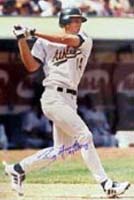
Ben Grieve
|
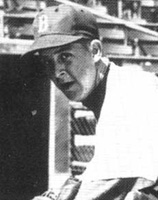
Karl Spooner |

J. R. Richard |
|
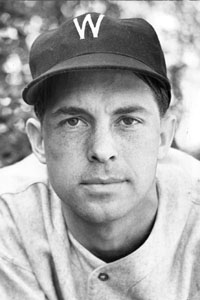
Cecil Travis
|
|
|